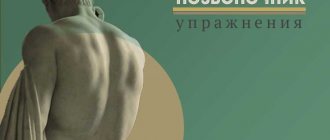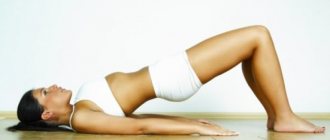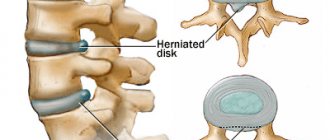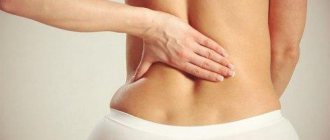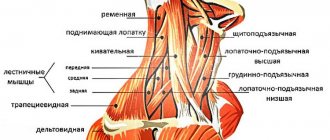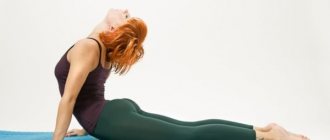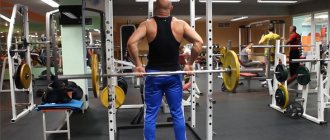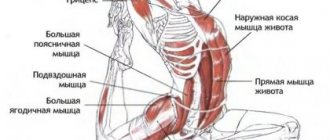The reason for this is a sedentary and unhealthy lifestyle, which conflicts with the characteristics of the body inherent in us by nature.
What is a typical day like for many people? We spend all our working time sitting at a table in a frozen position, bending over a computer keyboard or working with documents. When we come home, we sit in front of the TV, read books, or sit down at the computer again. And all this has a detrimental effect on the condition of our spine.
But the spine is the basis of the health of the entire body. And this is not an exaggeration, but a proven medical fact. What needs to be done to ensure that your spine serves you without fail throughout your life and you are not tormented by back pain?
Convenient workplace
If your profession involves spending a long time at your desk, you need to make it as safe as possible. To do this, the back of the chair or armchair should be adjacent to your back, supporting it, and your arms should rest on the armrests. It is optimal if the computer monitor is located slightly below eye level.
After each hour spent at your desk, take a break for 15 minutes: walk around, wave your arms, do a few squats, bend your torso and head.
Comfortable bed
Be sure to ensure good sleeping conditions. After all, at this time the spine is maximally unloaded and rests. Therefore, choose an orthopedic mattress that is suitable for your weight and height. It should be of such rigidity as to support all the natural curves of the body. An orthopedic pillow is also a desirable attribute of healthy sleep.
Proper physical activity
Many spinal problems are caused by an incorrect attitude towards carrying heavy loads . Carrying heavy objects is not the healthiest activity for your back, but if you do it correctly, you can significantly reduce the negative impact on your spine.
Lifting and lowering heavy objects must be done by squatting with a straight back, rather than bending over and unbending. When carrying the load, keep the load as close to your body as possible. This way you can reduce the load on your spine.
Sufficient physical activity is the key to a healthy spine. Swimming is the healthiest activity for your back. During swimming, the load is removed from the entire spine, and all the muscles of the body are well strengthened. Walking is one of the best physical exercises for the body, and it also perfectly relieves stress on the spine. Only walking should be moderately intense and without excess load.
Choosing bags and shoes
If you have to carry heavy bags often and for a long time, then use a backpack . Best of all - with wide straps and a rigid back, tightly fitting to the back.
Shoes play an important role in maintaining spinal health . If you wear high-heeled shoes, the arch of your foot does not function as a shock absorber, and the entire load falls on the spine. The optimal heel height is from 2 to 4 cm.
Winter shoes without a good tread force your back to be under constant tension, which has an adverse effect on its condition.
Treatment and preventive measures
A set of measures to improve the health of the spine necessarily includes therapeutic back massage . Massage improves blood circulation, relieves muscle tension, and has a beneficial effect on the general condition of the body. It can be used for both therapeutic and preventive purposes.
An effect somewhat comparable to a classic massage can be obtained using various massagers . They come in different types: roller, ball, needle. They allow you to relax and relieve fatigue on your own, without resorting to the services of a massage therapist.
of physiotherapeutic procedures provides tangible results for improving the condition of the spine . These include:
- electrophoresis,
- ultrasound,
- Charcot's shower,
- therapeutic mineral baths,
- magnetotherapy.
A set of physical therapy exercises can be performed not only in specialized gyms, but also at home. At the same time, along with special simulators, you can relieve the spine with the help of an ordinary horizontal bar.
However, in any case, you should first consult with an experienced neurologist, because not everyone is suitable for all of the listed procedures. And some of them need to be carried out in strictly limited quantities so as not to harm the body. During your consultation, our doctor will definitely give you valuable advice on how to unload your back in your individual case.
Our specialists
UNLOADING THE SPINE: exercises for the back
Take 3-5 deep breaths: inhale through your nose and exhale through your mouth. As you exhale, mentally release pain and tension.
Typically, in this position, lower back pain intensifies, and breathing makes it possible to relieve the increased pain.
If it is very difficult for you to immediately lie on your back, then first lie on your stomach and breathe, releasing tension from the lower back, and then roll over onto your back.
After this, bend your knees and place your feet as wide as possible.
Take a deep breath, pushing your stomach out. As you exhale, tighten your abdominal muscles and press your lower back into the floor. Repeat 3-5 times. For severe pain, do it without unnecessary strain.
Then straighten your legs and lie down, breathing calmly, for 1 minute.
Technique 2.
Bend your knees again and place your feet as wide as possible. The back is relaxed, the arms lie along the body. Take a deep breath and as you exhale, lower your right knee toward the floor inward. As you inhale, lift your knee. Next exhale, perform the same movement with your left leg. Repeat the inward movements with each knee alternately 3-5 times.
Then straighten your legs and breathe calmly, relaxing internally.
Technique 3.
Bend your knees and pull your knees towards your stomach. Use your hands to press your knees well. Try to breathe calmly and deeply, mentally passing air through your lower back.
Add free small turns left and right. Just sway for 1-2 minutes at a rhythm convenient for you and with a small amplitude.
Then release your hands and place your feet on the floor.
Take a deep breath and, as you exhale, straighten your legs.
Lie quietly for another 1 minute, observing your breathing. Then carefully turn onto your side and sit down.
Only then rise to your feet.
Take the first step towards lower back health! Do these simple exercises right now and feel the release of tight muscles and relief.
Our health is in our hands! You yourself can completely restore the health of your lumbar back if you have the knowledge how to do it. Or you can sign up for classes with us at the Manipura yoga studio.
Important advice on all complexes
Regardless of which option of exercise therapy was chosen and for what purpose it is performed, doctors strongly recommend maintaining accuracy and smoothness of all movements. Without a preliminary warm-up, exercise for back pain can do much more harm than good and pleasant sensations. In addition, after completing the complex, it is also worth doing a certain action. For example, sit on your heels and tilt your body down, while trying to touch your head to the floor.
Exercises to unload the spine
For the speedy restoration of spinal structures, especially after physical exertion, it is necessary to create certain conditions. One of these conditions is its unloading (stretching).
Regularly performing techniques to unload the spine allows you to restore some of its functions, namely:
- create sub-atmospheric pressure in the intervertebral discs.
As a result, it will be easier for nutrients to penetrate into the nucleus pulposus of the intervertebral disc through the endplates and hyaline plates;
— ease muscle tension (especially the deep back muscles);
- reduce pressure on the articular surfaces, which will give them the opportunity to recover better;
- increase the distance between the vertebrae, and with it the size of the intervertebral foramina through which the neurovascular bundles pass.
As a result of this, the outflow of venous blood from the spinal cord is restored, which prevents the development of varicose veins in it and free access of arterial blood carrying oxygen and glucose to the brain.
In the case of compression of the nerve fibers passing through the intervertebral foramina, when the spine is unloaded, their function is restored, as is the function of the tissues and organs that they innervate.
To summarize, we can conclude that as a result of unloading the spine, the innervation of organs and tissues, blood and lymph circulation in the tissues of the spine are restored, metabolic processes in the intervertebral discs and intervertebral joints are restored, the shape of the intervertebral disc is restored if previous activity was accompanied by poor posture, etc. .
Below is a list of some exercises to unload the spine.
1. Starting position (i.p.) – hanging on the bar, back muscles relaxed.
a) Inhale (to relax the intercostal muscles), stretch your toes to the floor, the spine stretches, the pelvis and legs drop down.
b) Place your feet on a pre-prepared chair, restore your breathing and carefully, without jumping, lower yourself to the floor, maintaining correct posture.
2. I.
p. - the same.
Free rotation of the pelvis to the right and left during inhalation. Coming off the crossbar as in the previous exercise.
3. I. p. - lying on your back on the mat, arms to the sides, legs bent at the knees as much as possible, feet on the floor.
Alternately tilt your legs to the right and left, gradually increasing the angle of inclination until your knees touch the floor.
SOD (breathing pattern) - voluntary breathing.
4. I.p.
reclining on your back, legs half-bent, elbows resting on the mat, shoulders (shoulder - the section of the arm between the elbow and shoulder joints) at an acute angle to the floor (elbows shifted towards the lower back).
Consistently press the lumbar, then the lower thoracic spine onto the mat and lie on your back.
The position of the shoulders and the consistent lowering of the body allows you to relieve the spine in the area from the sacrum to the interscapular region. Repeat 2-3 times.
To unload the spine, you can use available means.
For example, while leaning against the backs of chairs, inhale and relax the leg muscles. At the end of the exercise, you need to get back on your feet and restore your breathing.
To conclude the list of exercises aimed at unloading the spine, we give a description of the method of unloading it, which does not require any sports equipment, improvised means, or certain conditions. This method of unloading the spine, tested by us, is applicable in any situation, anywhere, at any time.
The essence of this method is that a person places his hands on the front surface of the thighs at the inguinal fold so that the fingers are facing forward and outward.
The arms are straightened at the elbow joints. To fulfill this condition, the shoulder joints can be raised. The feet are pressed to the floor. Being in this starting position, you need to inhale, pause, and, without bending your arms, but with relaxed back muscles, try to lower your pelvis down.
The maximum time spent in this position is limited by the time you hold your breath, and the minimum time is approximately 5-8 seconds. This time is enough to achieve the desired effect. When unloading the spine in this way, you can hear a characteristic crunch in it. After unloading is completed, you need to move your lumbar region forward, straighten your torso, taking the correct posture, and, after exhaling, restore your breathing.
Exercises
The author of these exercises is Paul Bragg, who can be considered one of the first valeologists.
He devoted his entire life to researching a healthy lifestyle and helped restore youth and health to many people. Paul Bragg himself was the best advertisement for the healing system he developed. Firmly convinced that everyone can and should live for at least 120 years, he died at the age of 96, but not “from old age”: he was covered by a giant wave while surfing off the coast of Florida.
First exercise
It will affect the nerve fibers serving the head and eye muscles, as well as the stomach and intestines.
That is, this exercise alone can relieve ailments such as headaches, eye strain, indigestion and intestinal disorders.
Lie on the floor on your stomach. Leaning only on your palms and toes, arching your back, lift your pelvis so that it is located above the level of your head. The head is lowered, feet are shoulder-width apart, knees and elbows are straight.
Then lower your pelvis as low as possible, almost to the floor. Arms and legs should be straight at all times.
Raise your head and throw it back.
The exercise should be done slowly, then lowering and then raising the pelvis and arching your back.
Plasmolifting: treatment of like with like
The method as such has been used for quite some time. In cosmetology, for example, this is one of the most popular and effective anti-aging procedures; it is also prescribed for skin damage and irritation. Plasmolifting is successfully used in the treatment of joint diseases and in dentistry.
The fact is that autoplasmotherapy, an original technique created by our compatriot, is not widely known. The technology was developed by Moscow professor Renat Akhmerov, Doctor of Medical Sciences and a practicing physician with extensive experience. Today, plasma lifting is used in many clinics and cosmetology centers not only in Russia, but throughout the world.
Plasmolifting of joints is a method based on the human body’s ability to self-heal. Our body has amazing regenerative capabilities, but sometimes it needs help to start the recovery process.
When blood plasma is injected into a joint, growth factors also “wake up” the cells of cartilage tissue. As a result, microtraumas heal, the surface of the joint becomes smooth, and even the structure of the bone tissue is restored.
There are many indications for plasma lifting of joints. The procedure is recommended for almost all types of joint diseases and injuries. It will help with injuries, arthritis and arthrosis of I and II degrees, deforming arthritis and arthrosis, bursitis, myofascial syndrome, coxarthrosis, tendinitis, osteochondrosis and heel spur.
A significant advantage of plasmolifting over other joint treatment methods is the small number of contraindications. Plasma from your own blood is absolutely compatible with the human body; it does not cause allergic reactions or side effects, addiction or intolerance. The only contraindications for the procedure are acute infectious diseases, blood diseases and malignant neoplasms.
Light back: 3 simple and effective exercises to unload your back!
The first movements are quite difficult, but then, if you do everything correctly, relief will come as the spine “swings” and relaxes.
Second exercise
This exercise has a beneficial effect on the nerve fibers leading to the liver and kidneys. Thanks to him, you will eliminate problems in the functioning of these organs.
The starting position is the same as in the first exercise. Also lift your pelvis and arch your back, resting on the palms of your straightened arms and your toes, also straight. Now turn your pelvis as far as possible to the left, descending as low as possible on your right side; then do the same in the other direction.
Arms and legs remain straight. Perform the movements slowly and always pay attention to the fact that your spine is stretching.
For beginners this is a very tedious exercise. By the way, it will never become too simple, but over time it will still be easier for you to do it, and not even because your muscles will become stronger, but because your nervous system will improve.
Third exercise
When performing this exercise, the spinal column is relaxed from top to bottom. All nerve centers are stimulated, the condition of the pelvic spine and pelvic organs is significantly improved.
The muscles attached to the spine and maintaining it in a stretched state become stronger, and thanks to this, the growth of intervertebral cartilage is stimulated.
Starting position: sit on the floor, leaning on your straight arms just behind your pelvis. Legs are bent. Raise your pelvis - now your body rests on your legs spread out, your knees bent and your arms straight. The spine is in a horizontal position. Then return to the starting position.
Repeat this exercise several times. Movements must be performed at a fast pace.
Fourth exercise
It especially strengthens that part of the spine that “manages” the stomach, but in general it has a beneficial effect on the entire spine and balances all processes in the body.
Lie on the floor on your back, legs extended, arms at your sides.
Bend your knees and, clasping them with your hands, pull them to your chest. Then raise your head and try to touch your chin to your knees. Maintain this position for 5 seconds.
Fifth exercise
This is one of the most effective exercises for stretching the spine.
In addition, it improves the condition of the nerve fibers that control the large intestine and normalizes its functioning.
The starting position is the same as in the first and second exercises: lying on the floor face down, leaning on your hands at chest level. Just as in the first exercise, lift your pelvis as high as possible, arching your back, and walk around the room in this position, leaning on straight arms and legs.
Some people begin to feel favorable changes within a week, and after 2-3 weeks these changes become permanent.
It will take time for the cartilage tissue of the intervertebral discs to begin to recover. Only with regular exercise will the spine become stretched and elastic.
Fast charging while sitting at the workplace for the back (in pictures)
If you cannot afford to perform the above complex, we present you with express exercises while sitting on a chair.
Do this quick system at least once a day. But if possible, do it more often. Ideally, every hour or two.
This option is the optimal solution for those who are deprived of normal physical activity. Prolonged static load negatively affects the cervical and thoracic spine. Along with the chair exercises already suggested, you can use others that can be performed several times a day, sitting at your desk, without distracting others.
Here are some of them:
- slow turns of the head to the side, leaning back at the end of the movement. After returning to the IP, repeat the exercise in the opposite direction;
- lower your head forward and try to rub your chest area with your chin. At the same time, try not to strain the back of your neck. After this, move your head back and make several slow rotations to the right/left;
- place your elbows on the table with your fingers connected in a “lock”, place your chin on your hands and make several bends in both directions;
- Place your hands on the table, pull your shoulders back, squeezing your shoulder blades together, and then straighten and extend your spine (like standing at attention).
